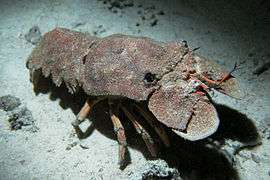Scyllarides
| Scyllarides | |
|---|---|
 | |
| Scyllarides latus | |
| Scientific classification | |
| Kingdom: | |
| Phylum: | |
| Subphylum: | |
| Class: | |
| Order: | |
| Infraorder: | |
| Family: | |
| Genus: | Scyllarides Gill, 1898 |
| Type species | |
| Scyllarus aequinoctialis Lund, 1793 [1] | |
Scyllarides is a genus of slipper lobsters.
Characteristics
Scyllarides is placed in the subfamily Arctidinae, which is differentiated from other subfamilies by the presence of multiarticulated exopods on all three maxillipeds, and a three-segmented palp on the mandible. The only other genus in the subfamily, Arctides, is distinguished by having a more highly sculptured carapace, with an extra spine behind each eye, and a transverse groove on the first segment of the abdomen.[2]
Taxonomic history
In 1849, Wilhem de Haan divided the genus Scyllarus into two genera, Scyllarus and Arctus, but made the error of including the type species of Scyllarus in the genus Arctus. This was first recognised by the ichthyologist Theodore Gill in 1898, who synonymised Arctus with Scyllarus, and erected a new genus Scyllarides to hold the species that De Haan had placed in Scyllarus.[3]
Species
Scyllarides comprises the following extant species:[4][5]
- Scyllarides aequinoctialis (Lund, 1793)
- Scyllarides astori Holthuis, 1960
- Scyllarides brasiliensis Rathbun, 1906
- Scyllarides deceptor Holthuis, 1963
- Scyllarides delfosi Holthuis, 1960
- Scyllarides elisabethae (Ortmann, 1894)
- Scyllarides haanii (De Haan, 1841)
- Scyllarides herklotsii (Herklots, 1851)
- Scyllarides latus (Latreille, 1802)
- Scyllarides nodifer (Stimpson, 1866)
- Scyllarides obtusus Holthuis, 1993 [6]
- Scyllarides roggeveeni Holthuis, 1967
- Scyllarides squammosus (H. Milne-Edwards, 1837)
- Scyllarides tridacnophaga Holthuis, 1967
In addition, two extinct species of Scyllarides are known from the Eocene of Europe:
References
- Lipke Holthuis (1951). "Proposed use of the plenary powers to render the generic name "Scyllarides" Gill,1898 (Class Crustacca, order Decapoda) the oldest available name for the species currently referred thereto". Bulletin of Zoological Nomenclature (2): 81–82.
- Lipke B. Holthuis (1991). "Key". FAO Species Catalogue, Volume 13. Marine Lobsters of the World. FAO Fisheries Synopsis No. 125. Food and Agriculture Organization. ISBN 92-5-103027-8.
- Lipke B. Holthuis (2002). "The Indo-Pacific scyllarine lobsters (Crustacea, Decapoda, Scyllaridae)" (PDF). Zoosystema. 24 (3): 499–683.
- Lipke Holthuis (1991). FAO Species Catalogue, Volume 13. Marine Lobsters of the World. FAO Fisheries Synopsis No. 125. Food and Agriculture Organization. ISBN 92-5-103027-8.
- Tin-Yam Chan (2010). Martyn E. Y. Low & S. H. Tan (eds.). "Annotated checklist of the world's marine lobsters (Crustacea: Decapoda: Astacidea, Glypheidea, Achelata, Polychelida)" (PDF). The Raffles Bulletin of Zoology (Suppl 23): 153–181. Archived from the original (PDF) on 2012-03-16.
- Lipke Holthuis (1993). "Scyllarides obtusus spec. nov., the scyllarid lobster of Saint Helena, Central South Atlantic (Crustacea: Decapoda Reptantia: Scyllaridae)". Zoologische Mededelingen. 67 (36): 505–515.
- Antonio de Angeli & Alessandro Garassino (2008). "Pseudosquilla lessinea n. sp. (Crustacea, Stomatopoda, Pseudosquillidae) and Scyllarides bolcensis n. sp. (Crustacea, Decapoda, Scyllaridae) from the lower Eocene (Ypresian) of Monte Postale (Altissimo, Vicenza, NE Italy)". Atti della Società Italiana di Scienze Naturali e del Museo Civico di Storia Naturale di Milano. 149 (2): 167–178.
- Joe S. H. Collins & Jeff Saward (2006). "Three new genera and species of crabs from the Lower Eocene London Clay of Essex, England" (PDF). Bulletin of the Mizunami Fossil Museum. 33: 67–76.